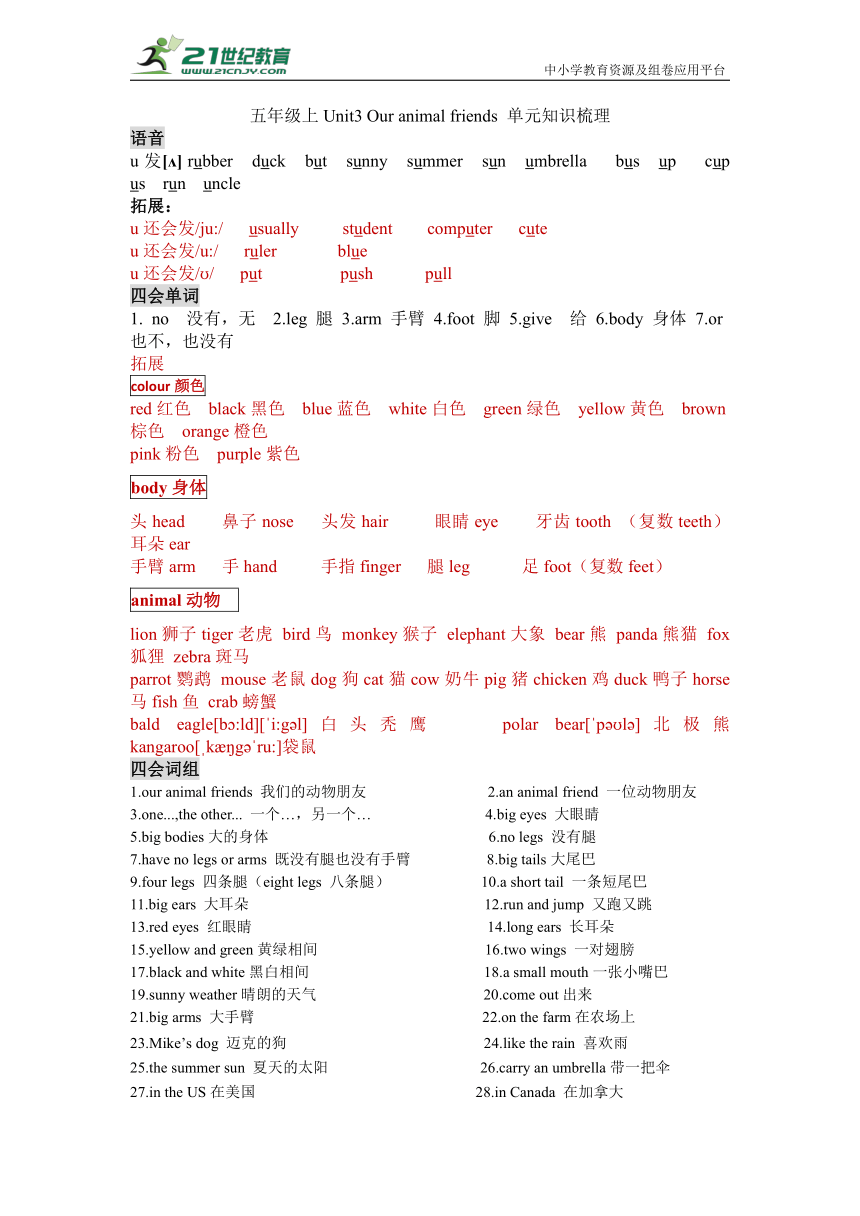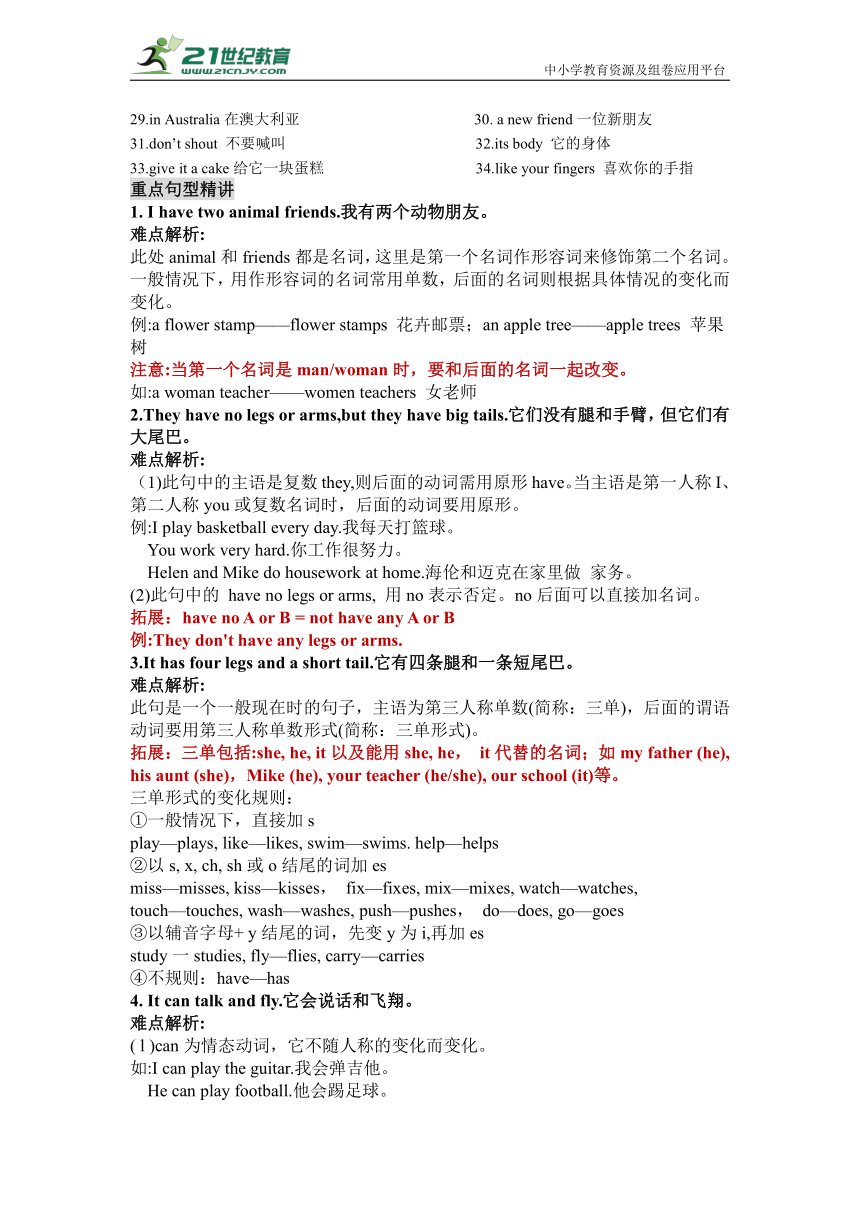Unit3 Our animal friends 单元知识梳理
文档属性
| 名称 | Unit3 Our animal friends 单元知识梳理 |  | |
| 格式 | docx | ||
| 文件大小 | 141.9KB | ||
| 资源类型 | 试卷 | ||
| 版本资源 | 牛津译林版 | ||
| 科目 | 英语 | ||
| 更新时间 | 2021-08-02 16:45:29 | ||
图片预览


文档简介
五年级上Unit3
Our
animal
friends
单元知识梳理
语音
u发[?]
rubber
duck
but
sunny
summer
sun
umbrella
bus
up
cup
us
run
uncle
拓展:
u还会发/ju:/
usually
student
computer
cute
u还会发/u:/
ruler
blue
u还会发/?/
put
push
pull
四会单词
no
没有,无
2.leg
腿
3.arm
手臂
4.foot
脚
5.give
给
6.body
身体
7.or
也不,也没有
拓展
colour颜色
red红色
black黑色
blue蓝色
white白色
green绿色
yellow黄色
brown棕色
orange橙色
pink粉色
purple紫色
body身体
头head
鼻子nose
头发hair
眼睛eye
牙齿tooth
(复数teeth)
耳朵ear
手臂arm
手hand
手指finger
腿leg
足foot(复数feet)
animal动物
lion狮子tiger老虎
bird鸟
monkey猴子
elephant大象
bear熊
panda熊猫
fox狐狸
zebra斑马
parrot鹦鹉
mouse老鼠dog狗cat猫cow奶牛pig猪chicken鸡duck鸭子horse马fish鱼
crab螃蟹
bald
eagle[b?:ld][?i:g?l]白头秃鹰
polar
bear[?p??l?]北极熊
kangaroo[?k??g??ru:]袋鼠
四会词组
1.our
animal
friends
我们的动物朋友
2.an
animal
friend
一位动物朋友
3.one...,the
other...
一个…,另一个…
4.big
eyes
大眼睛
5.big
bodies大的身体
6.no
legs
没有腿
7.have
no
legs
or
arms
既没有腿也没有手臂
8.big
tails大尾巴
9.four
legs
四条腿(eight
legs
八条腿)
10.a
short
tail
一条短尾巴
11.big
ears
大耳朵
12.run
and
jump
又跑又跳
13.red
eyes
红眼睛
14.long
ears
长耳朵
15.yellow
and
green黄绿相间
16.two
wings
一对翅膀
17.black
and
white黑白相间
18.a
small
mouth一张小嘴巴
19.sunny
weather晴朗的天气
e
out出来
21.big
arms
大手臂
22.on
the
farm在农场上
23.Mike’s
dog
迈克的狗
24.like
the
rain
喜欢雨
25.the
summer
sun
夏天的太阳
26.carry
an
umbrella带一把伞
27.in
the
US在美国
28.in
Canada
在加拿大
29.in
Australia在澳大利亚
30.
a
new
friend一位新朋友
31.don’t
shout
不要喊叫
32.its
body
它的身体
33.give
it
a
cake给它一块蛋糕
34.like
your
fingers
喜欢你的手指
重点句型精讲
1.
I
have
two
animal
friends.我有两个动物朋友。
难点解析:
此处animal和friends都是名词,这里是第一个名词作形容词来修饰第二个名词。一般情况下,用作形容词的名词常用单数,后面的名词则根据具体情况的变化而变化。
例:a
flower
stamp——flower
stamps
花卉邮票;an
apple
tree——apple
trees
苹果树
注意:当第一个名词是man/woman时,要和后面的名词一起改变。
如:a
woman
teacher——women
teachers
女老师
2.They
have
no
legs
or
arms,but
they
have
big
tails.它们没有腿和手臂,但它们有大尾巴。
难点解析:
(1)此句中的主语是复数they,则后面的动词需用原形have。当主语是第一人称I、第二人称you或复数名词时,后面的动词要用原形。
例:I
play
basketball
every
day.我每天打篮球。
You
work
very
hard.你工作很努力。
Helen
and
Mike
do
housework
at
home.海伦和迈克在家里做
家务。
(2)此句中的
have
no
legs
or
arms,
用no表示否定。no后面可以直接加名词。
拓展:have
no
A
or
B
=
not
have
any
A
or
B
例:They
don't
have
any
legs
or
arms.
3.It
has
four
legs
and
a
short
tail.它有四条腿和一条短尾巴。
难点解析:
此句是一个一般现在时的句子,主语为第三人称单数(简称:三单),后面的谓语动词要用第三人称单数形式(简称:三单形式)。
拓展:三单包括:she,
he,
it以及能用she,
he,
it代替的名词;如my
father
(he),
his
aunt
(she),Mike
(he),
your
teacher
(he/she),
our
school
(it)等。
三单形式的变化规则:
①一般情况下,直接加s
play—plays,
like—likes,
swim—swims.
help—helps
②以s,
x,
ch,
sh或o结尾的词加es
miss—misses,
kiss—kisses,
fix—fixes,
mix—mixes,
watch—watches,
touch—touches,
wash—washes,
push—pushes,
do—does,
go—goes
③以辅音字母+
y结尾的词,先变y为i,再加es
study一studies,
fly—flies,
carry—carries
④不规则:have—has
4.
It
can
talk
and
fly.它会说话和飞翔。
难点解析:
(
l
)can为情态动词,它不随人称的变化而变化。
如:I
can
play
the
guitar.我会弹吉他。
He
can
play
football.他会踢足球。
They
can
play
computer
games.他们会玩电脑游戏。
(2)talk意为“谈话,交谈”。
如:They
are
talking
in
the
living
room.他们在客厅交谈。
say,
speak,
tell,
talk都有“说”的含义,区别如下:
speak
用作不及物动词时,侧重指说话的动
作而非内容;用作及物动词时,其宾语
常为某种语言
Can
I
speak
to
Susan?请让苏珊接电话好吗?
She
speaks
English.她说英语。
say
通常用作及物动词,主要指说话的
内容
“See
you
soon.”
he
says
to
me,他对我说:“一会儿见。”
talk
主要指和某人说话和谈论某事,强调
双方“交谈”。一般和to,
with,
about
连用
He
often
talks
to/with
me.他经常和我谈话。He
is
talking
about
his
birthday
party.他正在谈论他的生日聚会。
tell
主要指告诉的内容,直接给某人讲述
或以间接的方式转述某事
He
tells
me
a
story.
=
He
tells
a
story
to
me.他给我讲了一个故事。
5.
Give
it
a
cake.给它一个蛋糕。
难点解析:
give
sb.
sth.意为“给某人某物”,还可以用give
sth.
to
sb.表达。本句同义句为:Give
a
cake
to
it.
例:I
want
to
give
him
a
storybook.
=
I
want
to
give
a
storybook
to
him.
我想要给他一本故事书。
语法
1.
have
/
has
用法:have
可用于除第三人称单数之外的所有人称之后,has
只能用于第三人称单数之后。
(第三人称单数:he,
she,
it
和能用he,
she,
it
来代替的所有单数)
或:(第三人称单数:是指除了I,you
和we、they复数之外的所有单数)
have
/
has
的肯定句结构为:
主语(除第三人称单数)+
have
+
某物。
主语(第三人称单数)+
has+某物。
have
/
has
的一般疑问句结构为:
Do+
主语(除第三人称单数)+
have+
某物
?回答用do/don’t
Does
+主语(第三人称单数)+have
+某物?
回答用does/
doesn’t
have
/
has
的否定句结构为:
主语(除第三人称单数)+
don’t+
have
+
某物。
主语(第三人称单数)+
doesn’t+
have
+
某物。
have
/
has
的特殊疑问句结构为:
a.
What
开头,表示:……有什么?
What
do
you
have?
你/你们有什么?
What
does
he
have?
他有什么?
b.
How
many开头,表示:……有多少……?
How
many
toys
do
you
have?
你/你们有多少个玩具?
How
many
fish
does
Nancy
have?
南希有多少条鱼?
2.区分no与not:都表示否定句,意思是“没有(一个)”
(1)
no单独用,无缩略形式。
not不能单独用,常跟在be动词,助动词和情态动词后,有缩略形式n’t.
如:isn’t;
don’t;can’t
(2)no可以与单数或复数名词连用,也可接不可数名词,=not
a/an
或not
any。
如:书包里没有书。There
is
no
book
in
the
bags.=There
is
not
a
book
in
the
bags.(单数)
There
are
no
books
in
the
bags.=There
are
not
any
books
in
the
bags.(复数)
3.can
+动词原形
(can
不随人称的变化而变化)
例如:
I
can
swim.
It
can
jump.
We
can
speak
English.
4.形容词性物主代词
包括:my我的,your你的,its它的,his他的,her她的,our我们的,their他们的
形容词性物主代词通常与名词连用,修饰名词。如:
its
tail它的尾巴
our
school我们的学校
their
cousin他们的表弟
5.and和or的用法
and用于肯定陈述句中,意思是“和”。如:
I
have
three
friends,
Jane,
Lily
and
Lucy.我有三个朋友,简、莉莉和露西。
or用于否定句,也可用于疑问句。
(1)or用于否定句,意思是“也不”,“也没有”。主观有完全否定的意味。如:
It
has
no
legs
or
arms.它没有腿,也没有手臂。
There
aren't
any
bears
or
lions
in
the
forest.森林里没有熊,也没有狮子。
(2)or用于疑问句,意思是“还是”或者“也行”。有让对方选择的意味。如:
Would
you
like
something
to
drink,
tea
or
coffee?你想喝点什么,茶还是咖啡?
6.身体部位相关单词
eye眼睛,ear耳朵,mouth嘴巴,nose鼻子,hair头发,foot脚,leg腿,arm手臂,hand
手,finger
手指,knee
膝盖,shoulder
肩膀,toe
脚趾,chest
胸,heart
心,eyebrow眉毛,eyelash眼睫毛,nail指甲,neck脖子
Our
animal
friends
单元知识梳理
语音
u发[?]
rubber
duck
but
sunny
summer
sun
umbrella
bus
up
cup
us
run
uncle
拓展:
u还会发/ju:/
usually
student
computer
cute
u还会发/u:/
ruler
blue
u还会发/?/
put
push
pull
四会单词
no
没有,无
2.leg
腿
3.arm
手臂
4.foot
脚
5.give
给
6.body
身体
7.or
也不,也没有
拓展
colour颜色
red红色
black黑色
blue蓝色
white白色
green绿色
yellow黄色
brown棕色
orange橙色
pink粉色
purple紫色
body身体
头head
鼻子nose
头发hair
眼睛eye
牙齿tooth
(复数teeth)
耳朵ear
手臂arm
手hand
手指finger
腿leg
足foot(复数feet)
animal动物
lion狮子tiger老虎
bird鸟
monkey猴子
elephant大象
bear熊
panda熊猫
fox狐狸
zebra斑马
parrot鹦鹉
mouse老鼠dog狗cat猫cow奶牛pig猪chicken鸡duck鸭子horse马fish鱼
crab螃蟹
bald
eagle[b?:ld][?i:g?l]白头秃鹰
polar
bear[?p??l?]北极熊
kangaroo[?k??g??ru:]袋鼠
四会词组
1.our
animal
friends
我们的动物朋友
2.an
animal
friend
一位动物朋友
3.one...,the
other...
一个…,另一个…
4.big
eyes
大眼睛
5.big
bodies大的身体
6.no
legs
没有腿
7.have
no
legs
or
arms
既没有腿也没有手臂
8.big
tails大尾巴
9.four
legs
四条腿(eight
legs
八条腿)
10.a
short
tail
一条短尾巴
11.big
ears
大耳朵
12.run
and
jump
又跑又跳
13.red
eyes
红眼睛
14.long
ears
长耳朵
15.yellow
and
green黄绿相间
16.two
wings
一对翅膀
17.black
and
white黑白相间
18.a
small
mouth一张小嘴巴
19.sunny
weather晴朗的天气
e
out出来
21.big
arms
大手臂
22.on
the
farm在农场上
23.Mike’s
dog
迈克的狗
24.like
the
rain
喜欢雨
25.the
summer
sun
夏天的太阳
26.carry
an
umbrella带一把伞
27.in
the
US在美国
28.in
Canada
在加拿大
29.in
Australia在澳大利亚
30.
a
new
friend一位新朋友
31.don’t
shout
不要喊叫
32.its
body
它的身体
33.give
it
a
cake给它一块蛋糕
34.like
your
fingers
喜欢你的手指
重点句型精讲
1.
I
have
two
animal
friends.我有两个动物朋友。
难点解析:
此处animal和friends都是名词,这里是第一个名词作形容词来修饰第二个名词。一般情况下,用作形容词的名词常用单数,后面的名词则根据具体情况的变化而变化。
例:a
flower
stamp——flower
stamps
花卉邮票;an
apple
tree——apple
trees
苹果树
注意:当第一个名词是man/woman时,要和后面的名词一起改变。
如:a
woman
teacher——women
teachers
女老师
2.They
have
no
legs
or
arms,but
they
have
big
tails.它们没有腿和手臂,但它们有大尾巴。
难点解析:
(1)此句中的主语是复数they,则后面的动词需用原形have。当主语是第一人称I、第二人称you或复数名词时,后面的动词要用原形。
例:I
play
basketball
every
day.我每天打篮球。
You
work
very
hard.你工作很努力。
Helen
and
Mike
do
housework
at
home.海伦和迈克在家里做
家务。
(2)此句中的
have
no
legs
or
arms,
用no表示否定。no后面可以直接加名词。
拓展:have
no
A
or
B
=
not
have
any
A
or
B
例:They
don't
have
any
legs
or
arms.
3.It
has
four
legs
and
a
short
tail.它有四条腿和一条短尾巴。
难点解析:
此句是一个一般现在时的句子,主语为第三人称单数(简称:三单),后面的谓语动词要用第三人称单数形式(简称:三单形式)。
拓展:三单包括:she,
he,
it以及能用she,
he,
it代替的名词;如my
father
(he),
his
aunt
(she),Mike
(he),
your
teacher
(he/she),
our
school
(it)等。
三单形式的变化规则:
①一般情况下,直接加s
play—plays,
like—likes,
swim—swims.
help—helps
②以s,
x,
ch,
sh或o结尾的词加es
miss—misses,
kiss—kisses,
fix—fixes,
mix—mixes,
watch—watches,
touch—touches,
wash—washes,
push—pushes,
do—does,
go—goes
③以辅音字母+
y结尾的词,先变y为i,再加es
study一studies,
fly—flies,
carry—carries
④不规则:have—has
4.
It
can
talk
and
fly.它会说话和飞翔。
难点解析:
(
l
)can为情态动词,它不随人称的变化而变化。
如:I
can
play
the
guitar.我会弹吉他。
He
can
play
football.他会踢足球。
They
can
play
computer
games.他们会玩电脑游戏。
(2)talk意为“谈话,交谈”。
如:They
are
talking
in
the
living
room.他们在客厅交谈。
say,
speak,
tell,
talk都有“说”的含义,区别如下:
speak
用作不及物动词时,侧重指说话的动
作而非内容;用作及物动词时,其宾语
常为某种语言
Can
I
speak
to
Susan?请让苏珊接电话好吗?
She
speaks
English.她说英语。
say
通常用作及物动词,主要指说话的
内容
“See
you
soon.”
he
says
to
me,他对我说:“一会儿见。”
talk
主要指和某人说话和谈论某事,强调
双方“交谈”。一般和to,
with,
about
连用
He
often
talks
to/with
me.他经常和我谈话。He
is
talking
about
his
birthday
party.他正在谈论他的生日聚会。
tell
主要指告诉的内容,直接给某人讲述
或以间接的方式转述某事
He
tells
me
a
story.
=
He
tells
a
story
to
me.他给我讲了一个故事。
5.
Give
it
a
cake.给它一个蛋糕。
难点解析:
give
sb.
sth.意为“给某人某物”,还可以用give
sth.
to
sb.表达。本句同义句为:Give
a
cake
to
it.
例:I
want
to
give
him
a
storybook.
=
I
want
to
give
a
storybook
to
him.
我想要给他一本故事书。
语法
1.
have
/
has
用法:have
可用于除第三人称单数之外的所有人称之后,has
只能用于第三人称单数之后。
(第三人称单数:he,
she,
it
和能用he,
she,
it
来代替的所有单数)
或:(第三人称单数:是指除了I,you
和we、they复数之外的所有单数)
have
/
has
的肯定句结构为:
主语(除第三人称单数)+
have
+
某物。
主语(第三人称单数)+
has+某物。
have
/
has
的一般疑问句结构为:
Do+
主语(除第三人称单数)+
have+
某物
?回答用do/don’t
Does
+主语(第三人称单数)+have
+某物?
回答用does/
doesn’t
have
/
has
的否定句结构为:
主语(除第三人称单数)+
don’t+
have
+
某物。
主语(第三人称单数)+
doesn’t+
have
+
某物。
have
/
has
的特殊疑问句结构为:
a.
What
开头,表示:……有什么?
What
do
you
have?
你/你们有什么?
What
does
he
have?
他有什么?
b.
How
many开头,表示:……有多少……?
How
many
toys
do
you
have?
你/你们有多少个玩具?
How
many
fish
does
Nancy
have?
南希有多少条鱼?
2.区分no与not:都表示否定句,意思是“没有(一个)”
(1)
no单独用,无缩略形式。
not不能单独用,常跟在be动词,助动词和情态动词后,有缩略形式n’t.
如:isn’t;
don’t;can’t
(2)no可以与单数或复数名词连用,也可接不可数名词,=not
a/an
或not
any。
如:书包里没有书。There
is
no
book
in
the
bags.=There
is
not
a
book
in
the
bags.(单数)
There
are
no
books
in
the
bags.=There
are
not
any
books
in
the
bags.(复数)
3.can
+动词原形
(can
不随人称的变化而变化)
例如:
I
can
swim.
It
can
jump.
We
can
speak
English.
4.形容词性物主代词
包括:my我的,your你的,its它的,his他的,her她的,our我们的,their他们的
形容词性物主代词通常与名词连用,修饰名词。如:
its
tail它的尾巴
our
school我们的学校
their
cousin他们的表弟
5.and和or的用法
and用于肯定陈述句中,意思是“和”。如:
I
have
three
friends,
Jane,
Lily
and
Lucy.我有三个朋友,简、莉莉和露西。
or用于否定句,也可用于疑问句。
(1)or用于否定句,意思是“也不”,“也没有”。主观有完全否定的意味。如:
It
has
no
legs
or
arms.它没有腿,也没有手臂。
There
aren't
any
bears
or
lions
in
the
forest.森林里没有熊,也没有狮子。
(2)or用于疑问句,意思是“还是”或者“也行”。有让对方选择的意味。如:
Would
you
like
something
to
drink,
tea
or
coffee?你想喝点什么,茶还是咖啡?
6.身体部位相关单词
eye眼睛,ear耳朵,mouth嘴巴,nose鼻子,hair头发,foot脚,leg腿,arm手臂,hand
手,finger
手指,knee
膝盖,shoulder
肩膀,toe
脚趾,chest
胸,heart
心,eyebrow眉毛,eyelash眼睫毛,nail指甲,neck脖子
